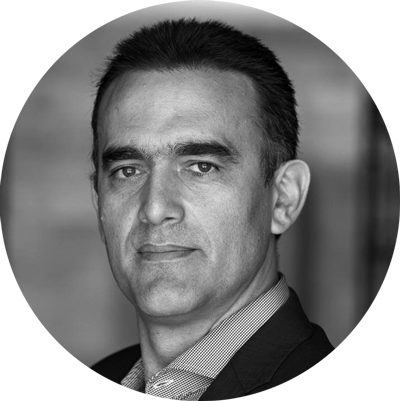12 July 2023
AUTHOR: Sam Dawes
The rise of AI-powered tools such as ChatGPT has sparked alarm among educators, and triggered conversations about its possible detriment to teaching and learning. But researchers from the University of South Australia are proving how artificial intelligence can enhance learning outcomes for students, equip teachers with advanced education tools, and totally overhaul the education sector for good.

Professor George Siemens is a renowned education technologist from the University of South Australia (UniSA). His research in learning analytics, digital learning, personalised learning and human-machine augmentation reveals the transformative potential of AI in education.
“Through learning analytics and AI-powered systems, we can unlock valuable, data-driven insights that help us understand how students learn,” Prof Siemens says.
“Advanced insights into student progress will enable us to design more effective and personalised educational experiences.
“The integration of AI will allow us to move beyond traditional models and embrace a more adaptive and learner-centric approach.”
Prof Siemens is also the Director of the Centre for Change and Complexity in Learning (C3L) at UniSA. His team focuses on the complex relationship between human and artificial cognition.
“We look at how humans can work with – not against – artificial intelligence to enhance their learning, sensemaking and productivity,” he says.
“Imagine a year seven science class where each student is using a smart tablet or smartphone app equipped with AI … the system will assess each student's proficiency level and dynamically adjust the content and pace of instruction accordingly.
“As students engage with interactive lessons and practise exercises, the system continuously monitors their performance, providing personalised feedback and targeted interventions.”
Using AI to personalise education

World-first research from UniSA’s C3L has led to the creation of ‘learner profiles’, a technology that is being trialled in several Australian schools.
The learner profiles provide real-time analysis of a student’s learning, study behaviours, and social and emotional wellbeing.
The project’s lead researchers, Dr Vitomir Kovanović and Dr Rebecca Marrone, say the technology has the potential to “significantly improve” the quality of teaching and learning in Australia.
“These profiles, all accessible via an online dashboard, will show how a student is learning at any point in time, which will help teachers quickly identify which children need additional support,” Dr Kovanović says.
Dr Marrone says that this means “teachers can respond to each child’s needs in a timely and appropriate manner”.
In addition to learner profiles, UniSA has developed an education software tool to improve the academic experiences of students, called ‘OnTask’.
OnTask, a project funded by the Federal Government, draws on the expertise of UniSA and other Australian universities.

Project lead and Dean of Programs (Information Technology & Mathematics) at UniSA, Professor Abelardo Pardo, says the next step is to amplify OnTask with AI.
“Currently, our software gathers and assesses data about students’ activities, which allows educators to design personalised feedback,” Prof Pardo says.
“Our work at UniSA with AI can improve this education software, as AI can simultaneously observe students’ academic activities, collate massive amounts of data, and provide suggestions for better learning experiences.”
Empowering educators with AI

Course development, lesson plans, attendance records and data entry are monotonous tasks that detract and distract from classroom teaching. Prof Siemens says AI has the capability to take on such tasks.
“The role of AI is not to replace teachers but to augment their capabilities,” he says.
“By automating administrative tasks, we free up their time to foster critical thinking, creativity and social-emotional skills that are uniquely human.
“Educators can craft lessons, tutorials and lectures that are more engaging, relevant and relatable to their students, and thereby generate a deeper understanding and long-term retention of knowledge.
“On a larger scale, we can use AI to create completely new University courses, saving a lot of time and thousands – if not millions – of dollars.”
Teaching students how to work with AI
Artificial intelligence is already shifting the goalposts on how people learn, and how they want to learn. So, how can the education sector respond, and how can teachers and students work effectively with AI?

UniSA Professor in Augmented and Networked Learning Maarten de Laat has addressed this issue with the creation of AI Playground – an AI learning environment created in collaboration with Intel and meldCX.
“The AI Playground helps educators bring AI learning experiences to the classroom,” Prof de Laat says.
“AI Playground teaches students to solve complex problems with AI, like building a rover that can explore Mars.
“Students are training, improving and working with AI in a way to solve real-world challenges.
“By gamifying AI in this way, teachers can spark rich conversations in the classroom about what we can achieve with AI, and what is ethical.
“AI Playground is a teaching tool that allows educators to introduce AI in an interactive, educational, and safe way.”
The integration of artificial intelligence in education holds immense potential for transforming teaching and learning practices.
The research of the University of South Australia highlights AI’s capability to enhance personalised education, unlock learner insights, and equip educators with the tools to transform classrooms and universities.
“The capabilities of AI present an opportunity to transcend traditional teaching approaches, reshape curriculum content and reimagine how we measure and evaluate learning outcomes,” Prof Siemens says.
You can republish this article for free, online or in print, under a Creative Commons licence, provided you follow our guidelines.


